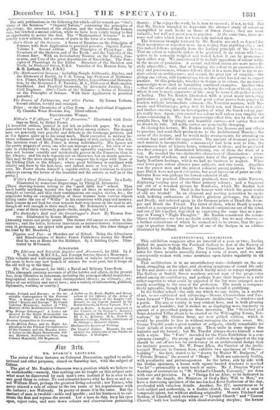Arts.
MR. RUSKIN'S LECTURES.
The series of three lectures on Coloured Decoration, applied to archi- tectural and other purposes, closed on Saturday last, with the subject of Colour.
The gist of Mr. Ruskin's discourse was a position which we believe to be unshakeable—namely, that nothing can be taught on this subject save what must be discovered by each man's own instinct if he is ever to do any good thing in colour. No real colourist knows why he does so and so ; not William Hunt, perhaps the greatest living colourist ; nor Turner, who never uttered a rule of colour in the ten years of his acquaintance with the lecturer ; nor Mulready. In poetry or music it is the same. But the instinct of man is twofold—noble and ignoble ; and his business is to cul- tivate the first and repress the second. Let a man do this, keep his eyes open, reject rules, and note down colours and observations pertaining
thereto : if he enjoys the work, he is sure to succeed ; if not, to fail. Not that Mr. Ruskin intended to depreciate the abstract study of colour as exemplified in such books as those of Owen Jones ; they are most valuable, but will not assist you in practice. At the same time, there are some real rules which have not been duly insisted upon. The instances brought forward by Mr. Ruskin are such as depend for their acceptance or rejection more upon feeling than anything else ; and this indeed follows naturally from the leading principle of the lecture. That no colour is valuable unless it be gradated, is an axiom which re- quires to be seriously weighed and tested before it can be pronounced upon either way. We understand it to include opposition of colour with- in the means of gradation. A second and third axiom are more immedi- ately admissible ; first, that of bringing the colour to an excessive deli- cacy and preciousness, whence follows that it is a mere libel to try to re- store colour on architecture ; and second, the great law of surprise,—the giving one colour, still harmonious, where the artist has led one to expect another. Of this principle, whether in design or in colour, the rnedimval manuscripts were cited as furnishing continual examples. Another idea —that the artist should avoid crimson, as being the colour of blood, except where it can be made expressive of life—may be termed altogether matter of feeling. This Mr. Ruskin illustrated with a great many ititere,t ing particulars ; pointing out that most good colour passes from purples to scarlets without intermediate crimson—the Venetian masters, with Ma- saccio and Chirlandajo, going first to brick red, and thence to scarlet ; and further entering into an investigation of what the Greek colour pur- ple really was. Again : you cannot see colour well unless you simplify the forms containing it. The best manuscripts effect this, not by the use of straight lines, but by simple and beautiful curves—not curves that can be drawn by rule. All noble curves are perpetually changing. In closing his lecture, Mr. Ruskin invited his hearers and any others to practise, and send their productions to the Architectural Museum, the scene of the lecture, and he would make arrangements for attending on certain days and offer his suggestions. The amount of dormant power in such matters is inconceivable : a manuscript had been sent to him, the spontaneous fruit of leisure hours, redundant in ideas; and he prod need two first attempts at illuminated lettering, one of them the work of a boy. He recalled the two distinctive characters of illumination : atten- tion to purity of colour, and excessive force of the grotesque,—a pecu- liarly Northern heritage, which we had no business to neglect. Who- ever loves pure colour chooses pure subjects, and vice versa. Angelico was the purest man and the purest colourist among painters. The im- pure Dutch were not good colourists, but good layers-on of paint merely : Salvator Rosa was perhaps the lowest colourist of all.
Among the practical illustrations produced, were two noble Turners, displaying varying uses of the three primary colours ; and a fragment cut out of a wrecked picture by Bonifazio, which Mr. Ruskin had bought abroad for 16s. Such is the honour with which the great works of old are treated ! In an eloquent and moving peroration he spoke with befitting enthusiasm of Diirer's glorious grotesque, the Knight and Death; and referred again to the German prints of Death the Aven- ger and Death the Friend. The latter of these, where Death is repre- sented as a masquerader playing his doomed companions out of the revel and out of life together, was cited as expressing the same idea as a pas- sage in Young's "Night Thoughts." Mr. Ruskin considered the resem blance fortuitous—we have no doubt correctly ; but we may observe, as a further coincidence of which he seemed not to be aware, that the pas- sage in question forms the subject of one of the designs in an edition illustrated by Stothard.




































 Previous page
Previous page